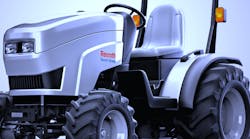No Stopping Tractors with Shift-on-Fly Hydraulic Drive
Download this article as a .PDF
High-end agricultural tractors commonly are equipped with power-shift transmissions or hydromechanical power-split gearboxes to optimize speed, power, and fuel efficiency for the specific task at hand. Tractors smaller than 70 hp, widely used by vegetable and fruit growers or landscapers, often are equipped with either mechanical transmissions or hydrostatic transmissions with medium-pressure axial-piston pumps.
Although the hydrostatic transmissions use a variable-displacement pump, they usually need a second gear ratio to provide a broader speed range. However, this second gear ratio can only be engaged when the tractor is stationary. Because the hydrostatic transmission is always engaged, it must be deactivated to interrupt the torque it transmits before gearbox can be shifted. This may not pose a problem, but users are beginning to expect many high-end features in these smaller tractors. These include continuously variable speed and acceleration throughout the speed range, simple handling with semi- or fully automatic gear shifting, fast shifting during travel, and the greater efficiency of a high-pressure, variable-displacement axial-piston pump and axial-piston motor.
The Rexroth Shift-on-Fly (SoF) system eliminates these shortcomings with a pump/motor combination and a high-end controller and software that allows the operator to shift gears while in motion, either semi-automatically in a given window with the push of a button or fully automatically. The Rexroth SoF is a two-speed shift transmission combined with a high-pressure (up to 450 bar nominal) hydrostatic circuit, which consists of an A4VG high-pressure, variable-displacement axial-piston pump, and an A6VM high-pressure variable-displacement bent-axis motor.
A Look at Drive Elements
The pump provides hydraulic power to the system and includes high-pressure relief valves with an integrated boost function and adjustable pressure cutoff. Flow direction changes smoothly when the swashplate is moved through its center position, and several control options are available to match the pump to its application. It can be controlled by an EP (electric proportional control), a DA (hydraulic control, speed-related), or an HW (hydraulic control, mechanical servo) plus DA, with a dedicated electronic hardware and software package.
In this application, an automotive speed control is used. The tractor’s accelerator pedal connects mechanically to the pump control module. In addition, a hand lever controls the diesel engine’s speed and overrides the accelerator pedal’s position. This lets the operator control speed of the diesel engine independent of the tractor’s travel speed.
A key element of this drive is the bent-axis motor with electroproportional control, which can regulate motor volume down to zero displacement . Because the transmitted hydraulic motor torque is 0 Nm at zero displacement, the input torque to the two-speed transmission also is zero, which makes shifting possible. A synchronizer equalizes the difference between the transmission input and output speeds. The variable, bent-axis design allows the motor to go from maximum to zero displacement and allows a wider speed range than a fixed motor.
Electronic Controller
The hydraulics are controlled electronically using a Rexroth BODAS RC2-2, a 16-bit microcontroller developed specifically for mobile applications. It provides programmable control of proportional solenoids and switching functions, making it well suited for both simple and complex open- or closed-loop controls, such as hydrostatic travel drives, working hydraulics, and transmission control. Pulse-width-modulated (PWM) solenoid currents provide low hysteresis and closed-loop control of solenoid currents independent of voltage and temperature. The controller meets or exceeds industry safety requirements with regard to ambient temperature, moisture, resistance to shock and vibration, and electromagnetic compatibility. It includes such safety features as redundant inputs and central safety cutoff for all outputs.
The RC2-2’s main function for this application is to control drive parameters and shifting based on its program and input signals. When the transmission operates in the shift window mode, the controller activates the shift indicator light. Once the operator activates the shift button, the controller sends a signal to the shift valve. This energizes one of the two solenoids and causes the coupling cylinder to shift from first gear to second or vice versa.
Because it uses a high-pressure, closed-circuit system with a variable-displacement motor, the SoF system extends the speed range by 20% over conventional drives. In addition, the system’s high-pressure variable components increase the tractive effort by up to 30%.





